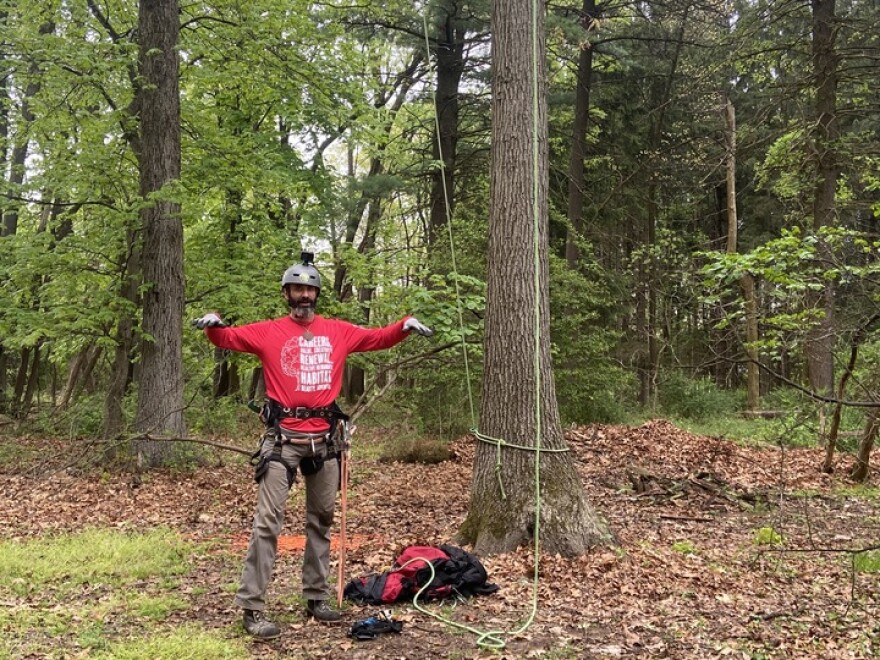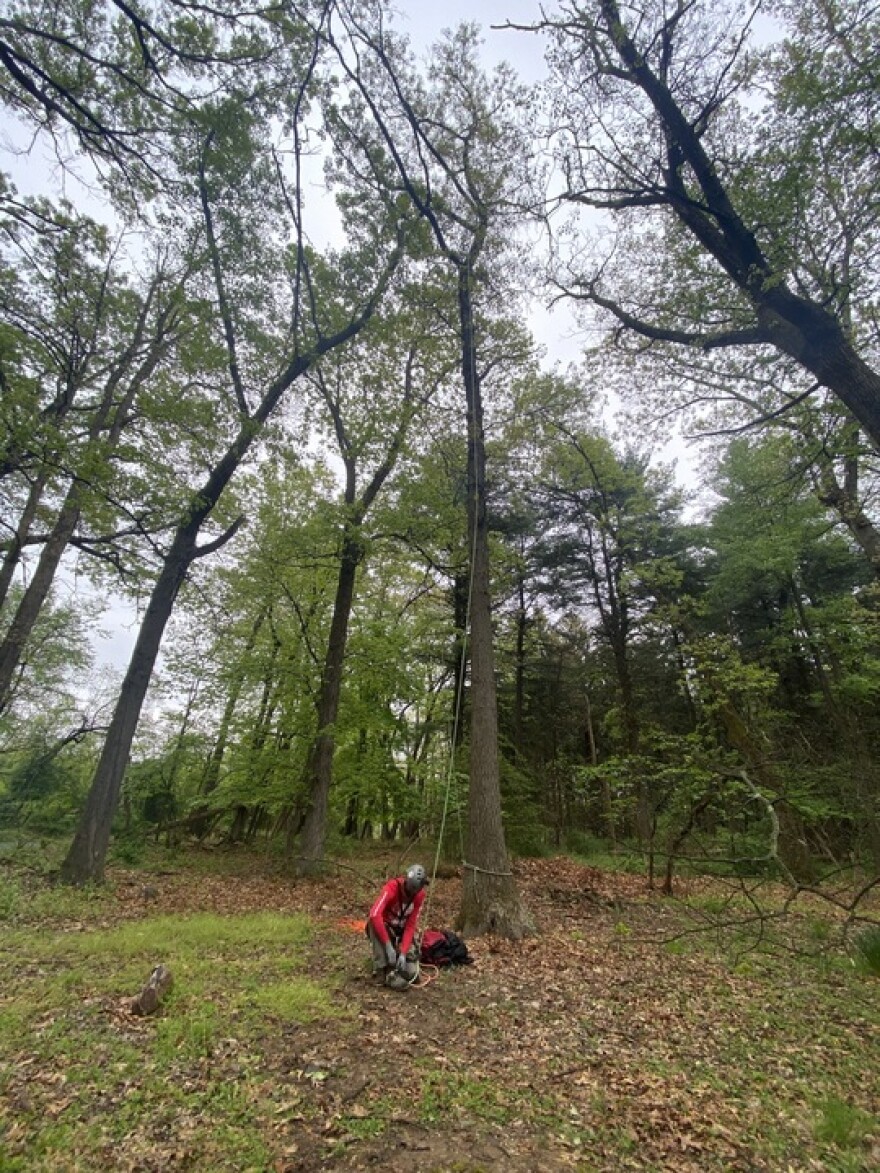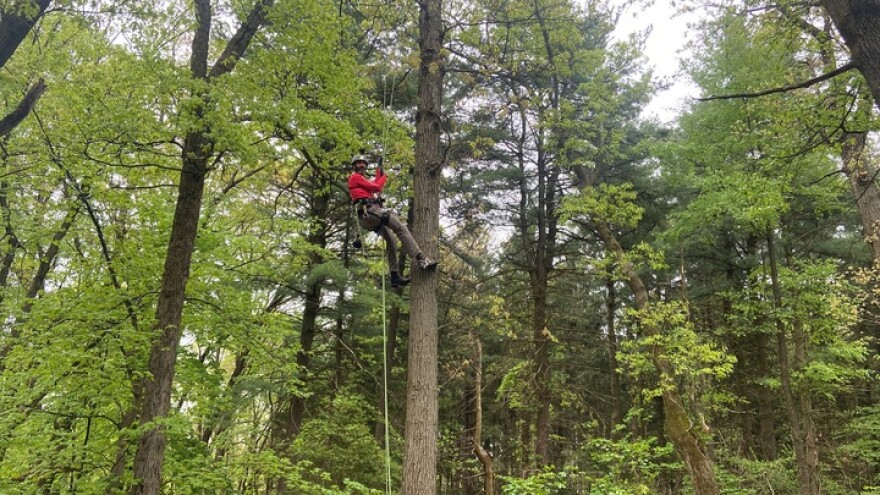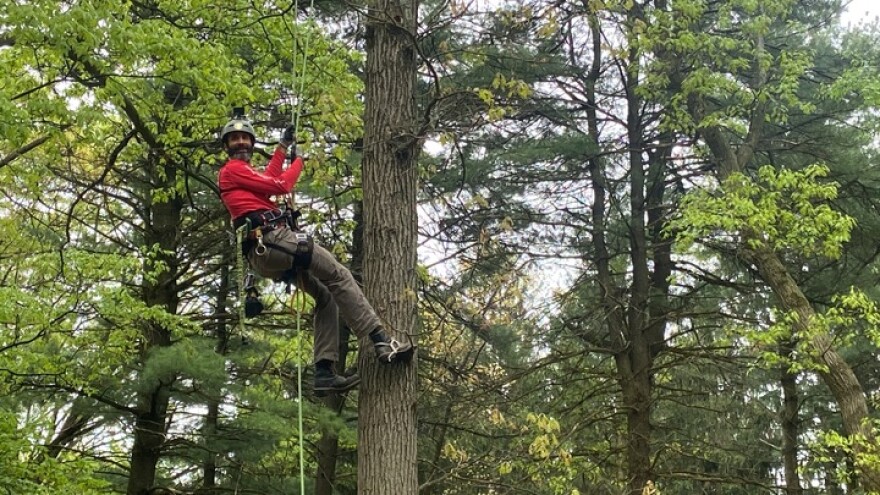SPRINGFIELD TWP., Pa. — A few yards past a stone marker delineating the border of Lehigh and Bucks counties, Van Wagner prepped his climbing gear in the light rain.
“I think my favorite surprises have been the places I get to on days like today, when it’s cloudy,” said Wagner, 47, of Danville, Montour County, as he coiled some rope, his helmet firmly in place. “And you kind of see a real otherworldly fog rolling in on the mountain top.”
After getting the rope situated, belting on a harness and checking his gear for safety, Wagner started his ascent. When he got near the top of an 80-foot oak tree, he paused to enjoy the view.
“It looks like the world falls away,” he said.
Wagner is no stranger to climbing trees, and he’s doing it with a purpose. The environmental educator, arborist and musician is attempting to climb the tallest tree at the highest point in each of the Commonwealth’s 67 counties. Saturday’s climb, after he played a set at Flint Hill Farm Educational Center’s Spring Open House in Upper Saucon Township, marked his 42nd completed.
Wagner’s purpose, he said, is to draw attention to the threats facing Pennsylvania’s forests, as well as encourage others to participate in conservation efforts.
“Our forests provide jobs, recreation — it's such a source of wealth in all meanings of that word, financial, spiritual, all those things."Van Wagner
“Our forests provide jobs, recreation — it's such a source of wealth in all meanings of that word, financial, spiritual, all those things,” Wagner said. “But it's not something we can just take for granted and assume it's always going to be a healthy forest. We have to manage it. We have to stay on top of the threats.”

‘Incalculable values and benefits’
Forests blanket 16.6 million acres, more than 60%, of the Commonwealth, according to the state Department of Conservation and Natural Resources.
“These forests provide incalculable values and benefits to Pennsylvania citizens and beyond,” according to the agency’s website. “They filter and protect drinking water and thousands of miles of streams. They provide critical habitat for plants and animals. They sequester carbon and clean our air. They provide places for us to marvel in the scenic beauty of landscape and a wide range of recreational opportunities, such as: hunting, hiking, camping [and] fall foliage viewing.
“They grow some of the finest hardwood timber in the world, fueling a $20 billion wood products industry that directly employs 60,000 people. Far beneath the soil, they yield a homegrown energy source of natural gas.”
And, the vast majority, about 12 million acres, are privately held by approximately 750,000 landowners.
However, the Commonwealth’s forests face threats from invasive plants and insects, as well as habitat loss.
Spongy moths, formerly known as gypsy moths, as well as emerald ash borers, have been an issue for decades. The former is known for a voracious appetite that can defoliate millions of acres, while the latter eats the inside of the live tissue of the tree.
“The number one cause of species decline worldwide is habitat loss,” Wagner said. “When you're talking about wildlife, birds, mammals — it's not over hunting. It's not poaching. It's not poisoning from factories. It's habitat loss.
“So that's got to be part of this conversation too.”

‘An impossible mission’
Wagner has completed climbs across the state, including the Lehigh Valley.
He completed his Northampton County climb on Jan. 14 on the top of Blue Mountain outside of Pen Argyl, according to his blog. In early April, he climbed a birch in Lehigh County. They were Wagner’s 32nd and 29th climbs, respectively.
Asked how he determines which tree, Wagner said he uses data from the U.S. Geological Survey to find the highest point in each county. Once he arrives, he finds the tallest tree he can safely climb.
“Sometimes, there's one like the Griswold family Christmas tree,” Wagner said, referencing1989 film “National Lampoon's Christmas Vacation,” and smiling. “Sometimes I get there and it's like there's golden light around it.”

Saturday’s climb was not so clear-cut, he said. Once he got to the highest point, he realized the tree wasn’t on the farm’s land, but privately owned.
“I lucked out because I didn't really have a Plan B,” he said. “But I knocked and the gentleman, he's like, ‘Can I help you?’ I said, ‘Can I climb your tree?’
“He gave me the OK.”
The entire climb, from set up to summit to descent, took less than an hour, and didn’t harm the tree.
Asked what needs to be done to help protect the state’s forests, Wagner said one word — education.
“What we need to be thinking of constantly is what's the next problem and how do we prevent it,” Wagner said. “I know that sounds like an impossible mission, because we're trying to prevent something we don't even know exists, necessarily, but the answer is education.
“Education — getting everyone involved in the conversation — is how we do better.”


